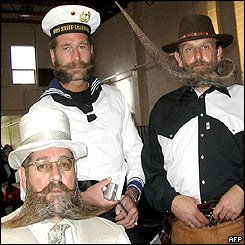What do you mean we need to leave?
 While avoiding studying for my Family Law final, I found this photo of myself (L) and Captain Shawn (R) moments before we caused Tomkin and Claire to seriously question their decision to move into Lex-Ham. Captain Shawn appears regularly in the pages of Petite Flower. Yep, not only has he gone out in public wearing a tan corduroy suit, and the dreaded socks and sandals combo - he's a man who uses a foam beer cozy for this Grain Belt.
While avoiding studying for my Family Law final, I found this photo of myself (L) and Captain Shawn (R) moments before we caused Tomkin and Claire to seriously question their decision to move into Lex-Ham. Captain Shawn appears regularly in the pages of Petite Flower. Yep, not only has he gone out in public wearing a tan corduroy suit, and the dreaded socks and sandals combo - he's a man who uses a foam beer cozy for this Grain Belt.He's ours and we ain't tradin'!














